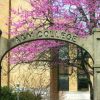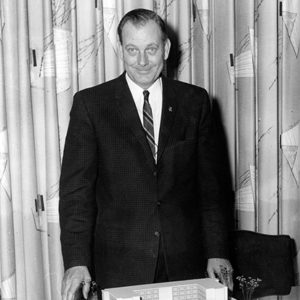calsfoundation@cals.org
Carl Raymond Reng (1910–1988)
Carl Reng served as president of what is now Arkansas State University in Jonesboro (Craighead County) from 1951 to 1975. When he started, the school had an enrollment of only 863 students and faculty numbering eighty-one. By the time he retired in 1975, the school had evolved into a major educational institution with more than 7,300 students, taught by a faculty of 342. In addition, he oversaw the school’s transition from a college to full university status, becoming the second such university in the state.
Carl Raymond Reng was born on May 13, 1910, to a farming family near Sioux Rapids, Iowa. His parents were John Gilbert Reng and Anna Marie Severson Reng, a Norwegian immigrant. Carl was the third of three sons.
Reng’s career as an educator began in Iowa in 1932. He went to Cornell School and then earned a BA from Buena Vista College in Storm Lake, Iowa. He took his first job as a teacher in “manual training,” coach, and principal at Cooper High School. Three years later, he became superintendent of the Huxley, Iowa, schools. Reng married Ruby Irene McLaughlin on August 15, 1935, in Schaller, Iowa. They were parents of two daughters, Marilyn and Barbara.
Reng completed a master’s degree at Drake University in 1940. That same year, he assumed the superintendency at Dunlap, Iowa, where he served until he enlisted in the U.S. Navy during World War II. Following two months of training at Princeton University, he was assigned to small-craft training for amphibious operations. Later, he was selected for leadership in the V‑12 Navy College Training Program and eventually attained the rank of lieutenant commander.
He and his family moved frequently as he helped set up V-12 programs on college campuses. After the war, he helped close out those same programs, serving in Dubuque, Iowa; Fayette, Missouri; Columbia, Missouri; and Dallas and Galveston, Texas. After four years of service, he was discharged into the Naval Reserve.
He resumed his advanced education, completing his doctoral degree in 1948 at the University of Missouri. The University of Arkansas (UA) in Fayetteville (Washington County) hired him as head of the school administration division of its graduate school, and the Reng family made plans to settle permanently in Fayetteville.
He was soon identified, however, as a prospect for president of what was then Arkansas State College. The Board of Trustees hired him as the institution’s fourth president on April 3, 1951. “I feel the presidency of Arkansas State College offers a challenge,” Reng told a reporter upon his arrival on campus, an understatement given the college’s small size and financial difficulties. Over the next several years, he steadily developed the institution, preparing it for its next big step.
Despite the forces that opposed the move, members of the Arkansas General Assembly were convinced by Reng and his supporters to rename the institution Arkansas State University in recognition of both its significant growth and the need to expand its education services to a wide region of Arkansas. The bill was signed into law by Governor Winthrop Rockefeller on January 17, 1967, and the change went into effect on July 1.
Several members of Reng’s administration, whom he had recruited to Arkansas State, were credited as key players in the drive for university status, including Ray Hall, Eugene W. Smith, Woody Haynes, and many others. The academic achievements and expansion of facilities were vital to the success of the college’s quest for university status.
The school’s new student center was named in his honor in 1964. At the time of his retirement, the ASU Herald reported that every building on the campus had been either erected or renovated during his tenure, including two that were under construction at that time. Among the facilities that were built or at least begun during his term were the Dean B. Ellis Library; the Carl R. Reng Center (later renamed Carl R. Reng Student Union); the Administration Building; the Fine Arts Center; the Laboratory Sciences Center; Indian Stadium (now Centennial Bank Stadium); the Health, Physical Education and Recreation Complex; and four multi-story residence halls.
The number of bachelor’s degree programs more than tripled, from twenty-one to sixty-nine, while he was president. A graduate degree program was begun in 1955, and it grew steadily. In 1969, educational specialist programs were added. The number of faculty members holding a doctorate or other terminal degree was only eleven at the time he came to Jonesboro and had jumped to 166 by the time of his retirement.
During his career at ASU, he participated in a number of professional and scholastic organizations, including Phi Kappa Phi, Phi Delta Kappa, Kappa Delta Pi, and the American Association of School Administrators. He was a member of the Southern Regional Education Board, the state Constitutional Revision Study Commission, and the Arkansas Council on Economic Education. A leader in the local Rotary Club, Reng also served a term as district governor. He was a member of the Jonesboro Chamber of Commerce, First United Methodist Church, and Jonesboro Elks Lodge No. 498, as well as a 32nd Degree Mason and a director on the Citizens Bank board.
His alma mater Buena Vista College (now university) and Hendrix College in Conway (Faulkner County) awarded him honorary doctorates in 1952 and 1965, respectively. He received U.S. Army medals for distinguished civilian service, largely because of his support for the Reserve Officer Training Corps (ROTC) program at ASU.
In his spare time, he enjoyed creating a mini-farm atmosphere at the president’s home, which sat on several acres in central Jonesboro. The property featured a pasture and barn in addition to a large wooded lawn, flower gardens, and an orchard. It was here he could get away from the demands of the job through his hobby of raising Shetland ponies, as well as chickens, rabbits, doves, dogs, cats and a couple of horses.
After retirement in 1975, he devoted more time to his hobby of wood-working. His wife, Ruby Reng, died on December 18, 1978; he and his second wife, Dona M. Reng, whom he married in 1980, lived in Jonesboro. He died on February 12, 1988, and he is buried at Jonesboro Memorial Park Cemetery.
For additional information:
Ball, Larry D., and William M. Clements. Voices from State: An Oral History of Arkansas State University. Jonesboro: Arkansas State University, 1984.
Dew, Lee A. The ASU Story: A History of Arkansas State University, 1909–1967. Jonesboro: Arkansas State University Press, 1968.
“Dr. Carl R. Reng Dies; Helped ASU Become University.” Arkansas Gazette, February 13, 1988, p. 9A, 10A.
Embrace the Past 1909–2009: Celebrating Our First Century. Jonesboro: Arkansas State University, 2011.
Thomas Moore
Arkansas State University
 Divergent Prosperity and the Arc of Reform, 1968–2022
Divergent Prosperity and the Arc of Reform, 1968–2022 Education, Higher
Education, Higher Military
Military Carl Reng
Carl Reng  Carl Reng
Carl Reng 




Comments
No comments on this entry yet.